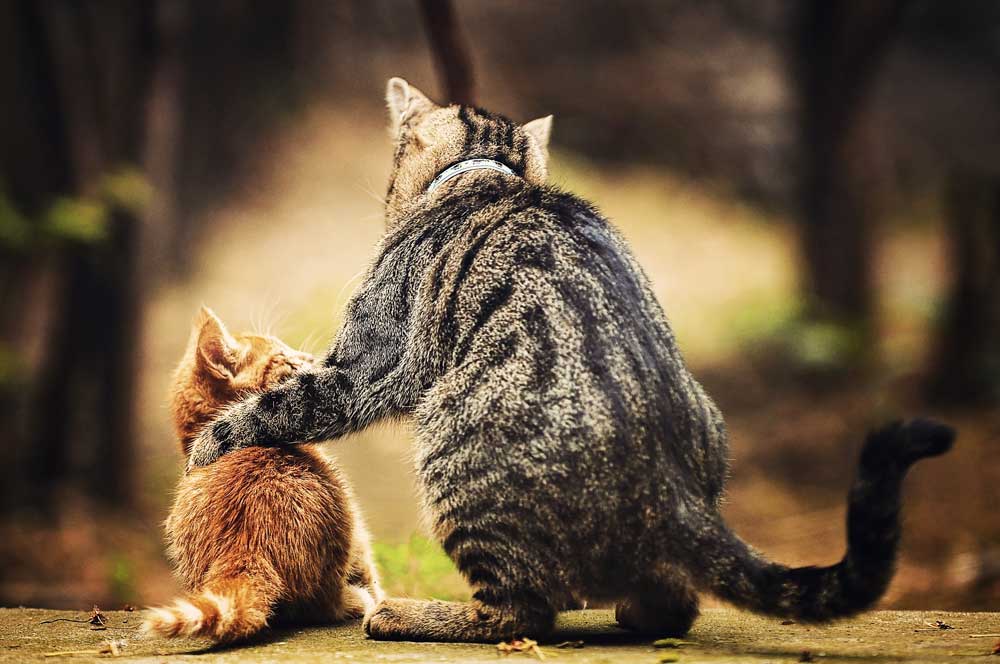A lot of tall tales are connected to cats. Some are false, while others are based on a grain of truth. Here are 8 of the most common — and strangest!
Cats and humans have lived in close proximity for over 12,000 years. We understand more about feline behavior than we used to, but they still retain an air of mystery, and we wouldn’t have it any other way. Unfortunately, that air of mystery has perpetrated a variety of myths that range from the silly to the unsafe. Based on old wives’ tales and half-truths, many of these myths persist even today, but plain ol’ common sense and a dose of science can set the record straight so we can enjoy a safer, smarter and happier relationship with our kitties!
Myth #1: Pregnant women should give up their cats.
Pregnant women, or those trying to become pregnant, do not need to give up their cats – but they do need to modify their kitty-care routine. Cats can pass on toxoplasmosis (caused by the Toxoplasma gondii parasite) after eating infected rodents, birds or other small animals. The parasite is spread in the cat’s solid waste and can have severe consequences on a developing baby or anyone with a compromised immune system. If you’re pregnant, assign litter box cleanup to another person; if no one else is available, wear disposable gloves and wash your hands with warm soapy water – something we should all do anyway.
It’s important to note that toxoplasmosis is most often transmitted to humans by eating raw, undercooked or contaminated meats. According to the CDC, 60 million people are infected with toxoplasmosis, but never know it because their immune systems generally prevent the parasite from causing illness.
Myth #2: Cats suck the breath out of babies.
Untrue. Cats have no supernatural powers that allow them to suck the breath from babies, or anyone else. Kitties are curious by nature, and have a strong sense of smell, so they may sniff around a baby’s mouth, especially after the infant has been fed. They also like to snuggle up in warm cozy places, and a baby’s crib is very inviting. Because accidents do happen, however, never leave a baby and cat alone together unsupervised.
Myth #3: Milk is a natural food for cats.
They may love milk, but it’s not good for them. Most cats are lactose-intolerant after kitten-hood and will experience diarrhea and gastrointestinal upset. We often see kitties lapping bowls of milk in cartoons and movies – but we don’t see the aftereffects! You can ask your vet about milk drinks made especially for felines, as a special treat from time to time, but the best drink for them is fresh clean water.
Myth #4: Felines always land on their feet.
Cats have a remarkable ability to right themselves in midair when they have enough time and space to do so (about two-and- a-half feet), but that doesn’t mean they can walk away unharmed from a long fall. “High rise syndrome”, for example, is a real issue in which cats fall from the windows or balconies of apartment buildings, suffering chest trauma, broken bones, facial and dental injuries, and even death. Kitty-proof your home or apartment by securing unstable furniture, and closing open windows or covering them with sturdy screens. Add a screened enclosure to your balcony if you live in an apartment building.
Myth #5: Cats don’t need as much veterinary care as dogs.
An astonishing 52% of household cats in the US have not had a wellness checkup in the last year, according to a study by Bayer Health Care and the American Association of Feline Practitioners. Over 81% of study respondents said their cats are in excellent health, 53% reported their kitties had never been sick or injured, and 81% said that they are self-sufficient, independent and low-maintenance. Clearly, consumer education about feline healthcare needs ramping up! All cats should have at least one checkup a year, while senior felines and those with chronic illnesses should have semi-annual checks. Cats are masters at disguising illness, and some health problems, like heart conditions and kidney disease, may have no visible symptoms.
Myth #6: Cats can survive outdoors on their own.
Our feline friends are expert hunters and have an air of wildness about them, and many feral cats seem to do just fine. But they are still safer indoors. Indoor cats live an average of three times longer than outdoor ones, whose average lifespan is just five years. Outdoor cats face many dangers, including disease, traffic, coyotes and other predators. If your cat enjoys being outside, train him to walk on a leash or install a screened enclosure.
Myth #7: My cat should have one litter of kittens before being spayed.
Not true. In fact, medical studies report that cats spayed before their first heat, at approximately six months of age, will have virtually no risk of developing mammary cancer or the life-threatening uterine disease, pyometra. Neutering male kittens decreases the chance of prostrate disease and eliminates the risk of testicular cancer. Spaying your cat won’t make her fat (unless she’s overfed and under-exercised) or change her personality – but it will prevent unwanted kittens contributing to cat over-population.
Myth #8: Cats have nine lives.
Seriously? Untrue, of course! Cats only have one life like the rest of us – and it’s up to us to make it as healthy and happy as possible by giving them proper nutrition, veterinary care and a safe, loving environment!








